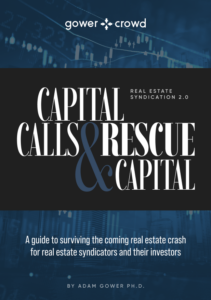Using Twitter to Grow Your Investor Network
By Adam Gower Ph.D.
You can use Twitter to locate high value real estate investors and build connections with ones you already know. You can also use the platform to build your brand. How can you become an influencer yourself?
It won't happen overnight but it is possible, and even likely if you're presenting your authentic self, using best practices, and committed to the process.
Focus on your audience and provide great content
We could probably read this advice on any social media site for just about every business. But we're talking about development and reaching high value real estate investors. Your brand isn't going to be the same as someone with another real estate specialty. You'll want to build trust by providing informative, realistic, and well-written information that only you can offer, that is hyper-focused on your unique value proposition, and that always speaks to your unique perspective on real estate investing.
Wait: well-written on Twitter? Of course! Twitter has a 280 character limit. It used to be 140 characters, which is very short. But it turns out shorter is better in many cases. Even though you can go longer, it isn't always to your advantage to do so. Shorter tweets still get higher engagement across the board.
And besides, the key component of any article, any social media post, any Tweet, is that you must always embed a call to action, a ‘CTA,’ that offers prospects the opportunity to read more. This advances readers in their journey to getting to know you.
Think of a Tweet as a teaser; something that provides a tantalizing insight that inspires the reader to wanting to know more from you. Your CTA leads them to your website where the opportunity to sign up for your newsletter presents another way for prospects to engage with your content. Twitter is, after all, nothing more than a gateway for prospects; one that gives you the opportunity to elevate your visibility to prospects, and that gives them the opportunity to find out more about you.
Use Twitter Analytics
Twitter has a built-in analytics tool that will show you how many people saw your tweet and how many engaged with it. You can see tweet activity on your phone by pressing the three small lines symbol (sometimes known as the ‘hamburger’) on the lower right side of any tweet.
On your Twitter desktop app, you can select "more" on the left menu and choose the same three line symbol and analytics to see an analysis of how many times your tweets were seen and your engagement.
Get access to our FREE weekly newsletter exclusively covering the latest updates from the real estate crowdfunding world
Don't be overly concerned about reaching tens of thousands of people. Your goal is to reach the people you're interested in reaching. You want to use Twitter to provide a solid brand image to anyone visiting your profile and timeline. You want to engage them confidently and productively to build a relationship.
How do other people see our tweets?
Most people use Twitter on their phones and the phone often shows only about 100 characters. If you can focus your tweets into a sharp 100 to 140 characters and include other elements, you'll be writing optimally to reach your potential audience.
Is shorter always better? Not always. If you have an important message to convey you can create a Twitter thread. By responding to your own tweet, this starts a thread where you can move from one part of your message to another, extending beyond the maximum 280 character limit.
Are images and videos important? Yes, but make sure your images are well-chosen. Tweets with images and video get higher engagement that those without. Just be aware of your audience's time. Few people have time to watch lengthy videos. If you can get your message across with a short video, do so.
What is good engagement on Twitter?
On Twitter, engagement can mean interaction with prospects. Did the person expand the picture or watch the video? Did they click through to an article link or your website? The median engagement rate across all tweets and industries was .048% in 2019 according to Digital Marketing Community. "Influencer" tweets got .036% engagements per post. "Media" was even lower at .009%.
What does this mean?
You're not trying to sell food or influence people to buy makeup or see a movie. Your goal is to reach and communicate with high value investors for your real estate syndications and to start to build a relationship with prospects.
Twitter's algorithms get smarter all the time. This is an advantage to you in building your brand on Twitter and reaching the audience of investors you want to reach. Twitter is getting better at allowing people to reach niche audiences through their algorithms. If you present your brand properly and convey valuable, actionable, reliable content, you can get an engagement rate of 2%, 3%, and even higher. Some reliable influencers in niche markets routinely engage their audience at 7 and 8% and more.
Twitter is a funny place (and yes, it can be humorous -- don't hesitate to use it to brighten your day and that of others, if it fits your brand). Like so much of our media these days, the amount of time and space offered to general "influencers" is outsized compared to what's going on out there in the world.
***
Your goal with Twitter should be to learn actionable intelligence to benefit your capital raising efforts, to be recognized as the expert you are, to promote your projects, and to connect with high net worth investors. When prospects first hear your name they will research you and look for you on the platforms they most like to use and though not everyone uses Twitter, those who do, like with other platforms, rely on it in part for information.
If you have only just started in real estate development, have completed no deals, have no email list, but know you want the freedom and wealth being a real estate developer brings, then I suggest your first step is to start evaluating deals so you can recognize a good one when you see it.
Here’s where you should start. You’ll learn everything you need to know – the different types of real estate, different development strategies, how real estate cycles influence the market, and all about due diligence.
If you want to find deals and raise money for them so you can start your real estate development business, then learning how to conduct due diligence so you can pitch your deals better to investors is a great place to start.
If you’ve already purchased one or more real estate project and are seeing more opportunities than you can finance, then now is the time to start building your investor network so you can finance all your next deals quicker.
You’ve already got some momentum; now start finding and educating prospects about what you’re doing so you can build an email list of people to pitch to when you’re ready to raise money for your next deal.
This is what we build for private clients all the time – it’s called the Investor Acquisition System and you can access the entire program right here so you can find prospects, and convert them into being deep pocketed, repeat investors in your deals.
If you are a seasoned pro with multi-cycle experience, a substantial portfolio, a decent deal pipeline, and find yourself spending too much time raising equity capital because you’re still doing it in-person, then it’s time you put technology to work for you.
The wonderful thing about doing this is that you’re not going to be doing anything different than you’re already doing and, guess what, you’ll never have to sit through investor meetings again.
Sounds crazy I know, but I lay the whole thing out for you in this white board workshop where I personally show you exactly what it takes for you to transform your equity raising into a fully automated, capital raising machine so you can find new investors while increasing commitments from your existing network.






